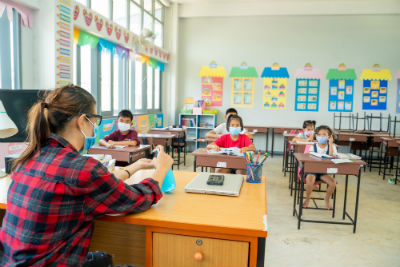By Dr. Zachary Pope, Kathleen Rogers and Paul Scialla

Back-to-school season is in full swing, and that means nearly 60 million K-12 students and over 3 million teachers will have returned to school over the next few weeks. Foremost on the minds of parents and teachers is keeping children safe and healthy. Attention on classroom indoor air quality remains critical as highly contagious airborne variants of SARS-CoV-2 (the virus that causes COVID-19) impact an increasing number of younger children.
According to the United States Environmental Protection Agency, indoor air pollutant levels can be up to five times and in some cases, even 100 times higher than outdoor levels. Air quality within schools is often poorer given that: 1) a higher number of individuals often occupy a given space at the same time (e.g., a single classroom) and 2) the ventilation and filtration systems in many schools are aging and incapable of adequately ventilating the space and filtering the air in classrooms.
The problem of poor air quality within schools, which can include higher levels of carbon dioxide, particulate matter, and volatile organic compounds, predates the COVID-19 pandemic, and has, in part, been caused by lack of monetary support for improved school infrastructure. In fact, according to the recently released 2021 State of Our Schools report, there is an $85 billion school facility infrastructure investment gap per year in our PK-12 public school facilities spending, representing a chronic and startling underinvestment in our nation’s schools. Similarly, in 2020, the U.S. Government Accountability Office found that 36,000 public schools need to update or replace multiple building features, such as the heating, ventilation, and air conditioning systems that contribute to indoor air quality.
Poor indoor air quality within schools is also a critical issue to address given that it is associated with an increase in school absences due to illness which, in turn, can affect students’ overall academic performance. A scientific study from the University of New South Wales found infrastructure renovations, including mold remediation and increased ventilation, resulted in improved standardized math and reading test scores. Harvard’s Healthy Buildings for Health Initiative also reviews the numerous benefits of improving the classroom environment, including indoor air quality on youth health. Further, as reported by the American Lung Association, elevated exposure to outdoor air pollutants is more common among low-income, as well as racial and ethnic minority groups, which has been associated with more health issues among those who are exposed. Equity is, therefore, also a relevant concern, as disadvantaged schools located in areas with higher outdoor air pollution may not have the necessary infrastructure to properly ventilate and filter the air within classrooms that infiltrates the school building.
To improve air quality standards across America’s school systems, indoor air quality testing and maintenance should be mandatory. While there are multiple references to air quality in the Senate version of the infrastructure package, rules for all 50 states and territories should be included and funded in the Reopen and Rebuild America’s Schools Act of 2021. Additionally, specific language is needed to ensure each school district has a plan in place for how they will improve their indoor air quality and protect their students and staff against COVID-19 and other respiratory illnesses, as well as air pollutants.
In the short term, however, Congress should strongly consider providing schools with the resources to implement recirculating portable air purification systems in classrooms – prioritizing units with particle filtration efficiency at the device level greater than or equal to 99.97%, the standard for high efficiency particulate air (i.e., HEPA) filters. Reducing the number of aerosol particles in the air reduces the chance of breathing in potentially infectious particles. A new study from the Well Living Lab, which was founded as a collaboration of Delos and Mayo Clinic, observed that supplementing an HVAC system with portable air purification units resulted in up to 5 times lower particle concentration in the air for some locations within the classroom. Additionally, and largely unique to this study, it was observed that portable air purification units reduced the speed at which particles accumulated on most surfaces throughout the room by approximately 33%.
Portable air purification units may, therefore, act as a scalable solution to help limit infectious aerosol transmission of COVID-19 and other respiratory illnesses as part of a multi-level mitigation strategy, while also improving overall indoor air quality. To achieve these outcomes within schools, urgent action is needed, with significant benefits for the health of both students and staff – something that would help us all breathe a little easier.
Dr. Zachary Pope, Research Scientist, Well Living Lab & Assistant Professor, Mayo Clinic; Kathleen Rogers, President, EARTHDAY.ORG; and Paul Scialla, Founder, CEO, Delos and Founder, International Well Building Institute. Thanks to American Forum for sharing this article.










